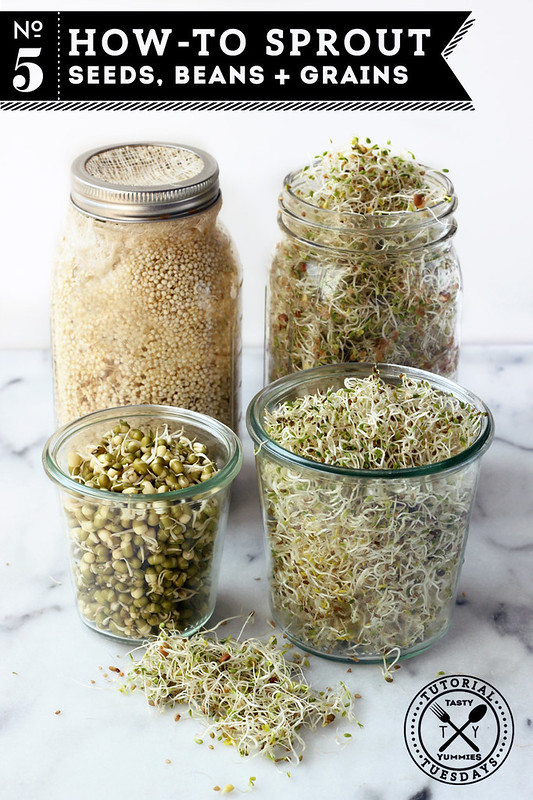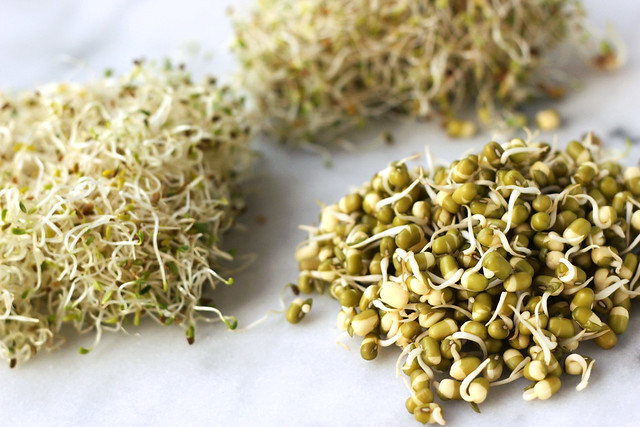-
How-to Sprout: Seeds, Beans + Grains
Much like making homemade almond milk, which I have done for years now, preparing sprouts at home, has now become a weekly thing for me. I absolutely adore sprouted foods and all of their many benefits. But, I have to be honest when I tell you the sprouts they sell at the store creep me out, a bit. Knowing just how short their shelf life is, it makes it hard for me to believe they are fresh and that their exposure to harmful bacteria has been limited. I would much prefer to make my own at home, where I know how fresh they are and exactly how they were handled. I started doing this late last year and I have become obsessed.
Sprouting is a way of creating “living plants”, loaded with nutrients and vitamins such as Vitamin C, B E and carotene. Some believe sprouted foods contain up to 15 times as many nutrients as their unsprouted counterparts. Sprouting also helps the absorption of minerals due to their ability to be better digested. Some people refer to sprouted foods as “pre-digested”, for this reason.
Sprouting takes time, but it’s much more of a waiting game, it doesn’t require a ton of work. Sprouted foods simply requires you to have patience and to be paying attention, tracking their sprouting time and making sure to tend to them, when needed. That’s about it.
Why Sprout?
As we discussed in both the nut butter and nut milk posts – many nuts, seeds, legumes and grains contain natural chemicals that protect them while growing, both from sprouting prematurely and also from predators. These protectors also act as enzyme inhibitors to us, meaning we get much less of the crucial nutrients from these foods than we should be. Plus, this “armor”, of sorts, makes digesting them much more difficult. Soaking these foods releases these chemicals, helping you to absorb your food’s essential minerals and nutrients. Additionally, by soaking the nuts with the removal of these nutritional inhibitors and toxic substances, the flavor and taste is much more ideal and appealing.(read more in depth about these chemicals and why we soak, here)
So, we are back to the soaking idea again. Soaking is not only necessary for sprouting to occur, but we are also unlocking the full nutritional potential of these foods, as we did with the nut butters and nut milks. After soaking, when that natural protective armor has been removed, the sprouting process can then occur. So basically, if soaking is the first step of increasing the nutritional benefits of these foods, then sprouting is the incredible finishing move to creating the perfect nutritional superfood out of something that would otherwise leave us feeling bloated and tired, due to the strain they would typically put on our digestion.
Sprouted foods, also known as “activated foods” are incredibly nutrient dense foods, they encourage production of healthy bacteria that aids in our digestion and in turn, boosts our immunity. Sprouts are great on salads, on top of soups or stews, in stir fries, inside of wraps or sandwiches, in smoothies – really they are great in any dish that you want to add a nutritional boost to.
What Can you Sprout?
Most seeds, legumes, grains and some nuts will sprout, but be aware some will not. Because many nuts you find in the stores have been pasteurized or treated with heat in some way, they aren’t technically raw and although soaking can activate and allow us access to their nutrients, sprouting likely won’t happen. Oftentimes, when I am simply looking for traditional sprouts, I will buy premixed ready to sprout blends of organic seeds and legumes exclusively meant for sprouting. It gives me a nice wide variety and I know that, since everything in the blend is meant for sprouting, it will do just that. See the bottom of this post for pre-made sprouting blends that I recommend. For the step-by-step photos, I used this organic blend, Spicy Salad Mix, which contains lentils, alfalfa, red clover, radish and black mustard seeds.
Once sprouted, you can also cook grains and legumes, as you normally would. Sprouted quinoa cooked in place of regular quinoa, is one of my favorite things as are sprouted lentils. Once sprouted, grains and legumes not only cook quicker than their dried counterparts, but they are, as you now know, much easier to digest and taste much better, as well.
Read the rest of this entry »
-
A Quick Guide to Gluten-Free Eating
I am sure many of my regular readers here are old pros at eating gluten-free, but maybe some of you are new to a strictly gluten-free diet (due to Celiac disease, a gluten intolerance or another medical/health reason), or perhaps you are looking to simply cut back or eliminate some gluten from your diet. Maybe you are being a really good pal, looking to learn more and find options for a friend or family member that is gluten-free. No matter what the reason, my simple overview of a gluten-free diet is meant to be used as a safe and quick tool while you are doing your own research on specific products and what you can and cannot tolerate (even within these “allowed” foods).
I hope you enjoy this list and find it to be a good resource if you are just starting out, or to share with family and friends that want to learn more about your restrictions.
A Quick Guide to Gluten-Free Eating

ALWAYS AVOID ON A GLUTEN-FREE DIET:
- Wheat (einkorn, durum, farro, graham, kamut, semolina, spelt)
- Rye
- Barley (malt, malt flavoring and malt vinegar are usually made from barley)
- Triticale (a cross between wheat and rye)
- Commercial oats contain gluten due to cross contamination in processing, only eat certified GF oats
Wheat goes by many names – other wheat products to avoid:
- Bulgur
- Durum flour
- Farina
- Graham flour
- Kamut
- Semolina
- Spelt
SAFE FOODS ON A GLUTEN-FREE DIET:
Alternative flours, grains, starches and thickeners that are inherently safe for celiac, gluten intolerance and wheat allergies include:
- Rice (white, brown, basmatic, jasmine, wild, risotto, sticky rice, rice cereal)
- Corn (maize) (grits, polenta, cornmeal)
- Potato, potato starch, potato flour
- Tapioca and tapioca starch
- Bean flours (chickpea, garbanzo, soy, fava, garfava)
- Sorghum
- Quinoa, quinoa flour and cereal flakes
- Millet and millet flour
- Rice flour
- Buckwheat
- Arrowroot starch
- Amaranth
- Certified gluten-free oats and oatmeal*
- Teff
- Montina
- Cornstarch (corn flour)
- Flax
- Nut flours (almond, chestnut, pecan, cashew, macadamia)
- Coconut flour
*Oats are naturally gluten-free and might be OK but please note when purchasing your oats, please make sure to choose packages that say “gluten-free”, as most commercial oats are contaminated with wheat when they are grown in the fields or from cross contamination in the processing plant. Some folks that are gluten-free don’t eat any oats, as they cannot tolerate them. Research indicates that pure, uncontaminated oats consumed in moderation (up to 1/2 cup dry oats daily) are tolerated by most celiacs. Everyone is different so please only eat them if you know you can tolerate then and consult with your physician or specialist before including in your regular diet.
Labels that clearly declare a complete list of ingredients are usually safest. You must read labels each and every time foods are purchased, as manufacturers can change ingredients at any time. As of 2006, wheat used in products will be identified on the label. Additionally, you may verify ingredients by calling or writing a food manufacturer and specifying the ingredients and the lot number of the food in question. State your needs clearly – be patient, persistent and polite.
WHAT ABOUT ALCOHOL?
Distilled alcoholic beverages and vinegars are gluten-free. Distilled products do not contain any harmful gluten peptides. Research indicates that the gluten peptide is too large to carry over in the distillation process. This process leaves the resultant liquid gluten-free. Wines and hard liquor/distilled beverages are gluten-free. Beers, ales, lagers and malt vinegars that are made from gluten-containing grains are not distilled and, therefore, are not gluten-free. There are many great gluten-free beers available.
FOODS THAT ARE NATURALLY GLUTEN-FREE:
- Fruits and vegetables
- Beans, seeds, nuts in their natural, unprocessed form
- Fresh eggs
- Fresh meats, fish and poultry (not breaded, batter-coated or marinated)
- Most dairy products
GLUTEN LIKES TO HIDE: Always Read Labels. Don’t be afraid to call the manufacturer if you are unsure.
Products to be careful of where gluten can be hiding: broth, bouillon, beers, ales, lager, breading & coating mixes, energy bars, syrups, communion wafers, french fries, croutons, dressings, drugs & over-the-counter medications, modified food starch, ice cream and frozen desserts, flour & cereal products, herbal supplements, imitation bacon (and other fake meats), veggie burgers, imitation seafood, marinades, nutritional supplements & vitamins, pastas, flavored vinegars, chocolate, candy, processed deli meats, sauces & gravies, hot dogs and vegan hot dogs, spice blends, self-basting poultry, soy sauce or soy sauce marinades, soups and soup bases, stuffings, thickeners (Roux), confectioner’s and brown sugar, herbal teas (watch for barley), jerky.
*Please remember that even the words “gluten-free” on a label do not always insure 100% gluten-free, due to cross contamination. Be cautious and be vigilant. Call companies and manufacturers, ask for detailed information or testing.
REMEMBER WHEN IN DOUBT, GO WITHOUT! IT IS NEVER WORTH IT!
When you are unable to verify ingredients or the ingredient list for a food is unavailable – DO NOT EAT IT!! No matter the amount consumed, it is not worth affecting your immune system nor is it worth the damage that will surely be done to the small intestines as a result, every time gluten is eaten. Whether or not symptoms or signs are present, it may be happening.










